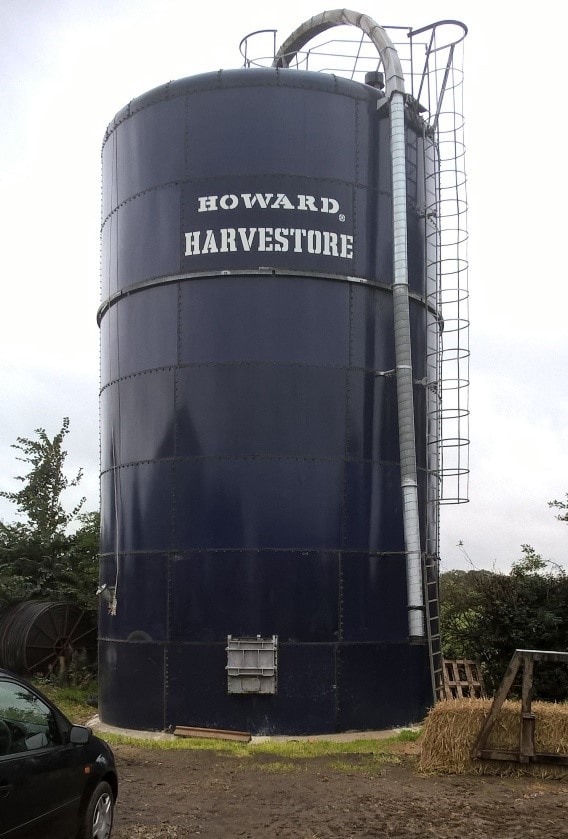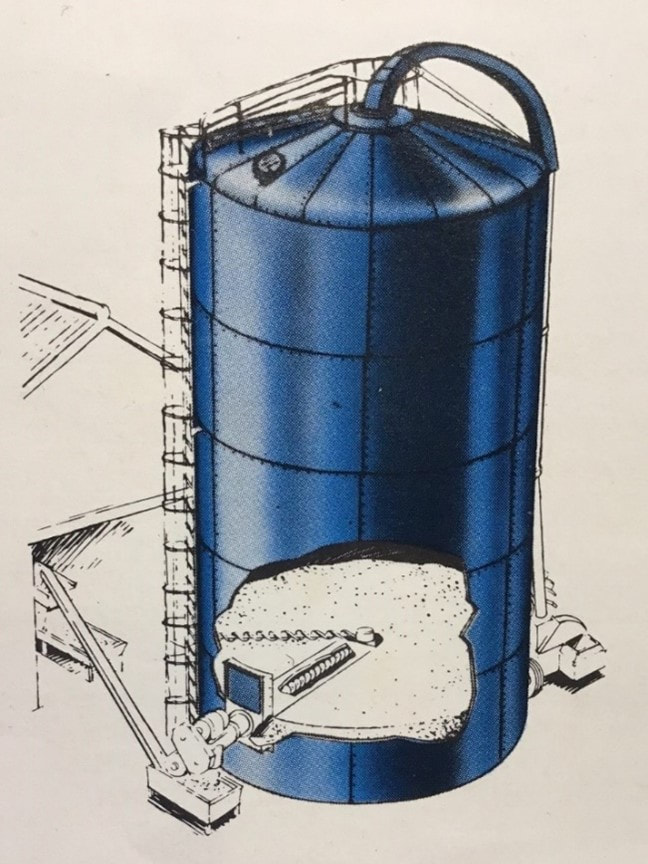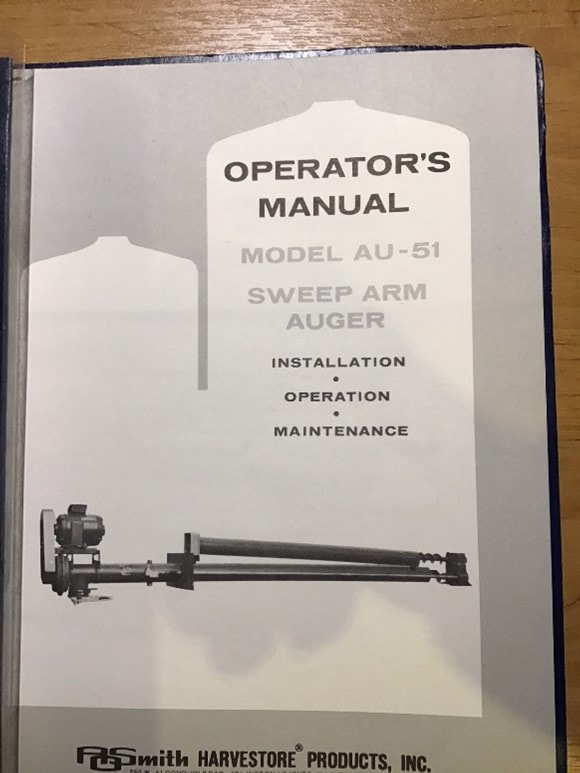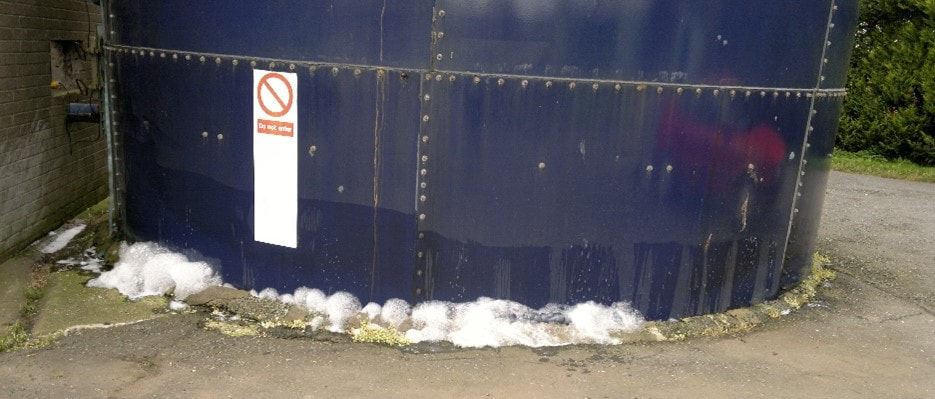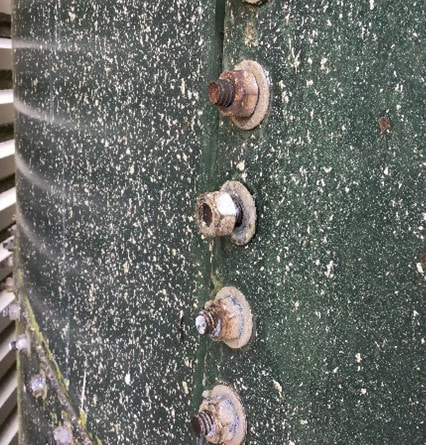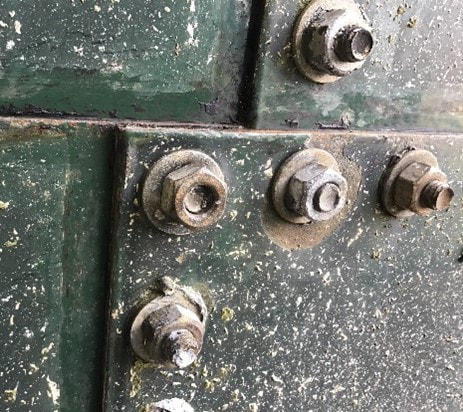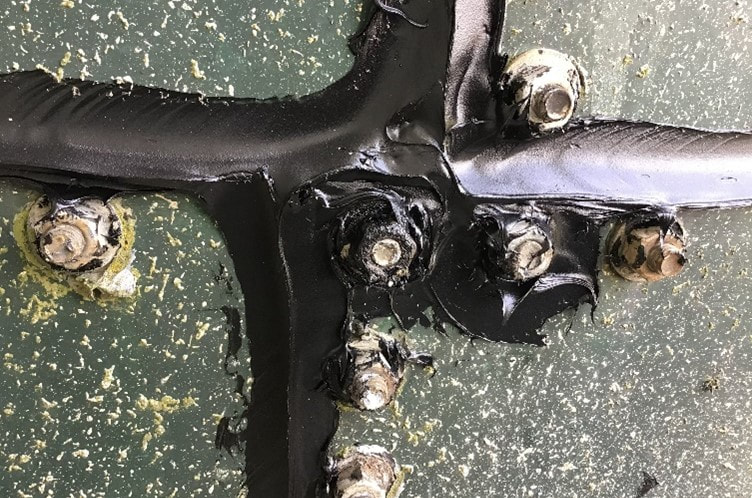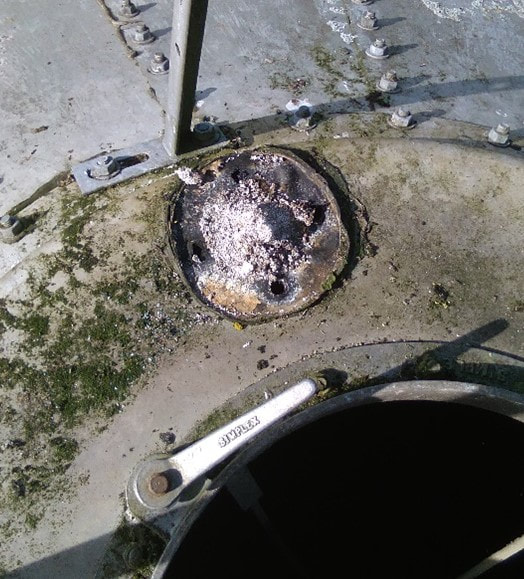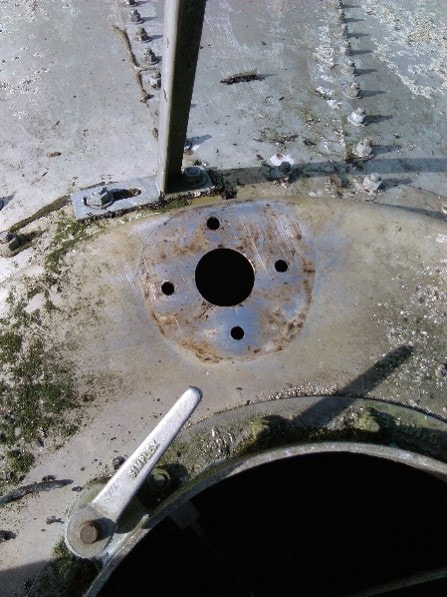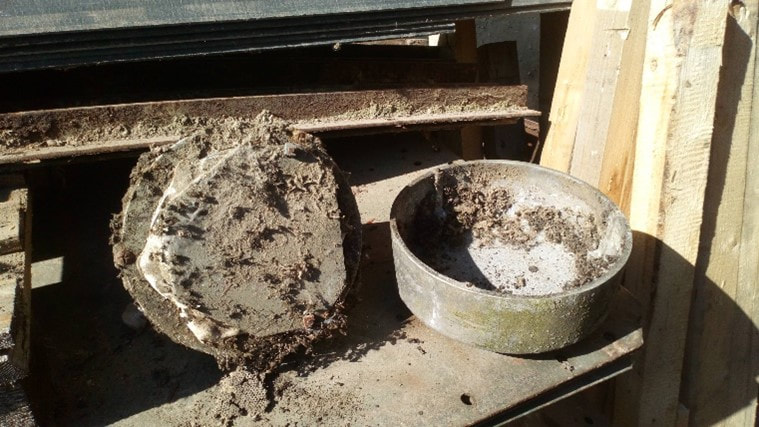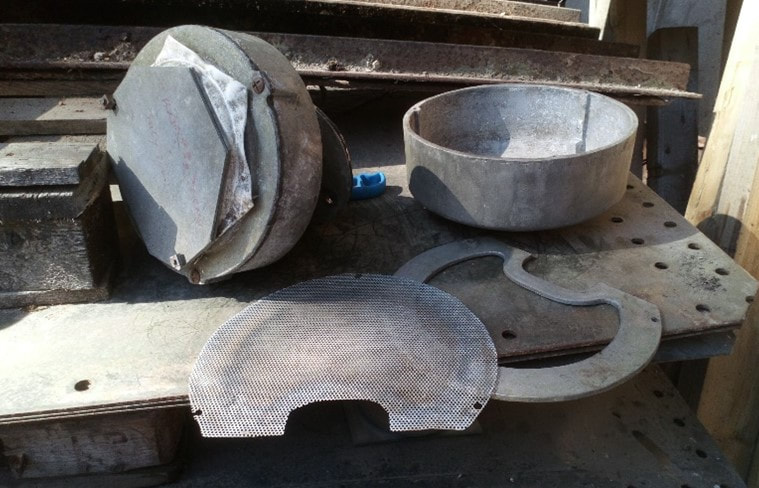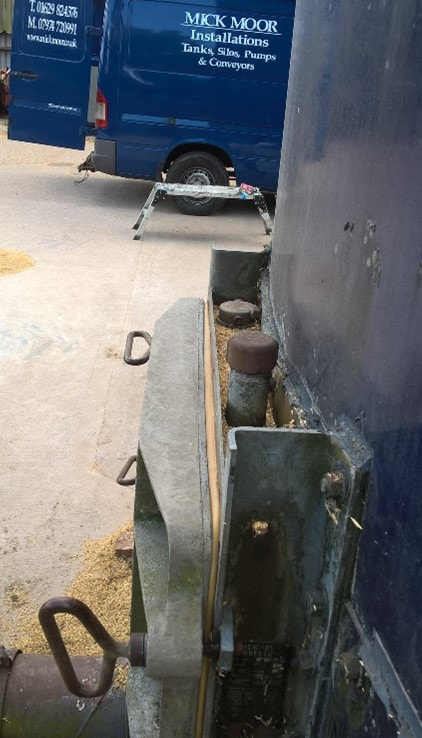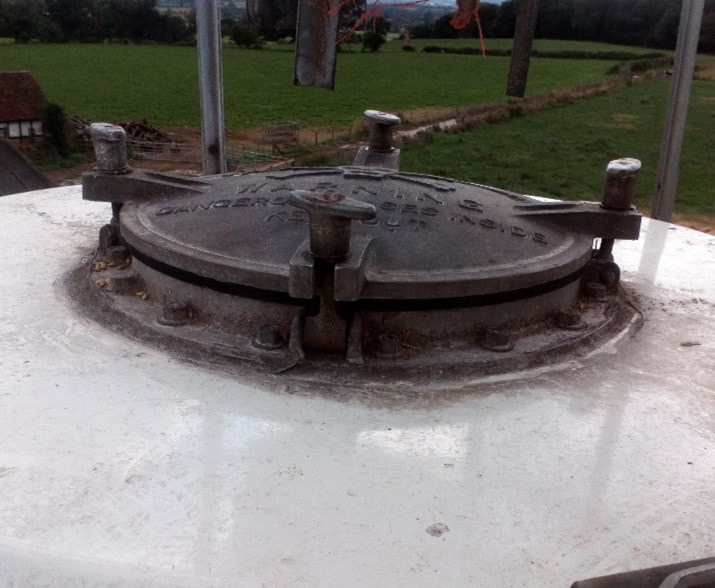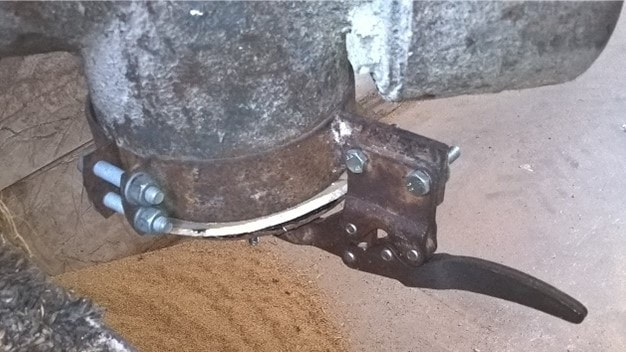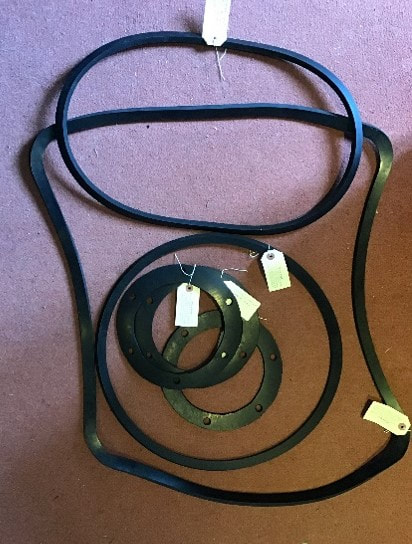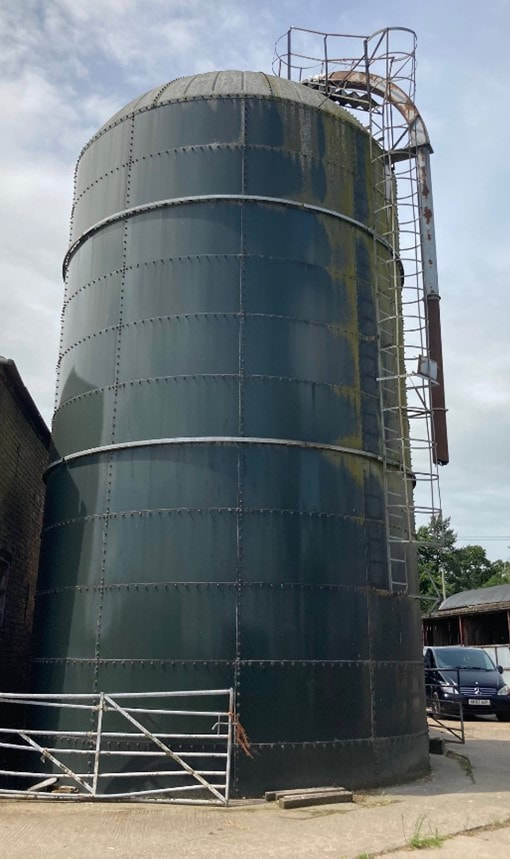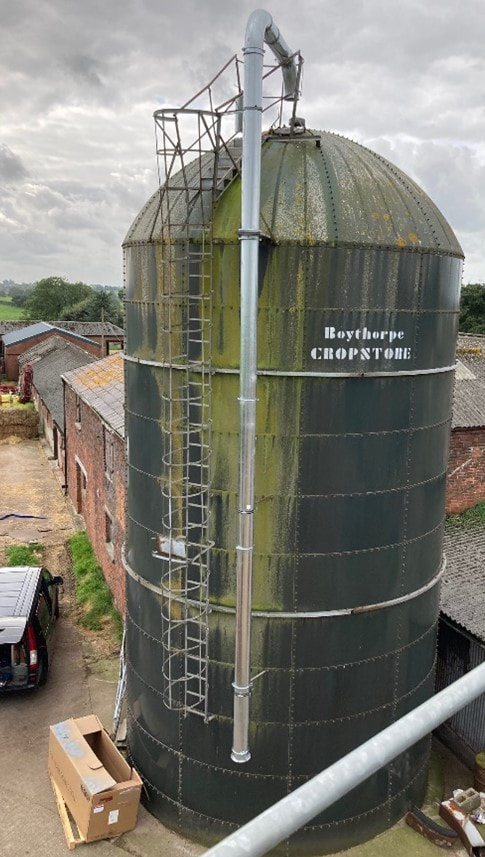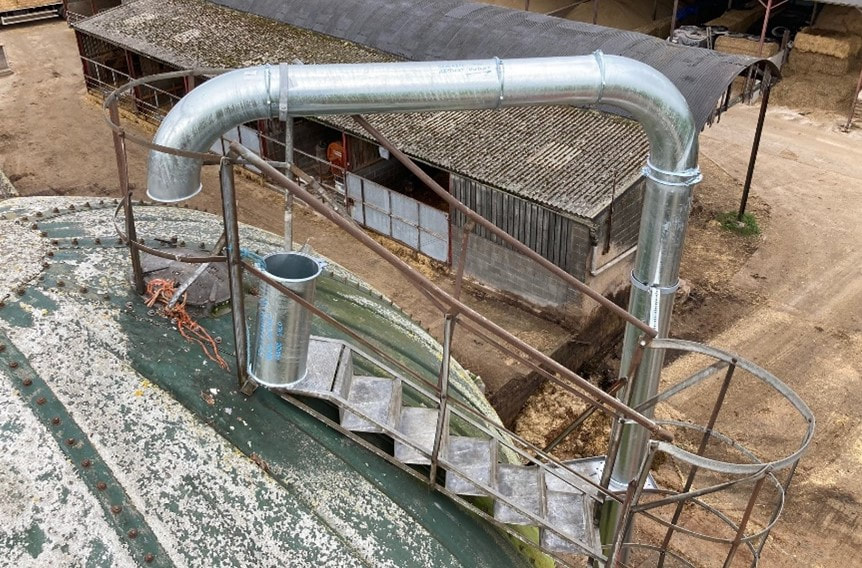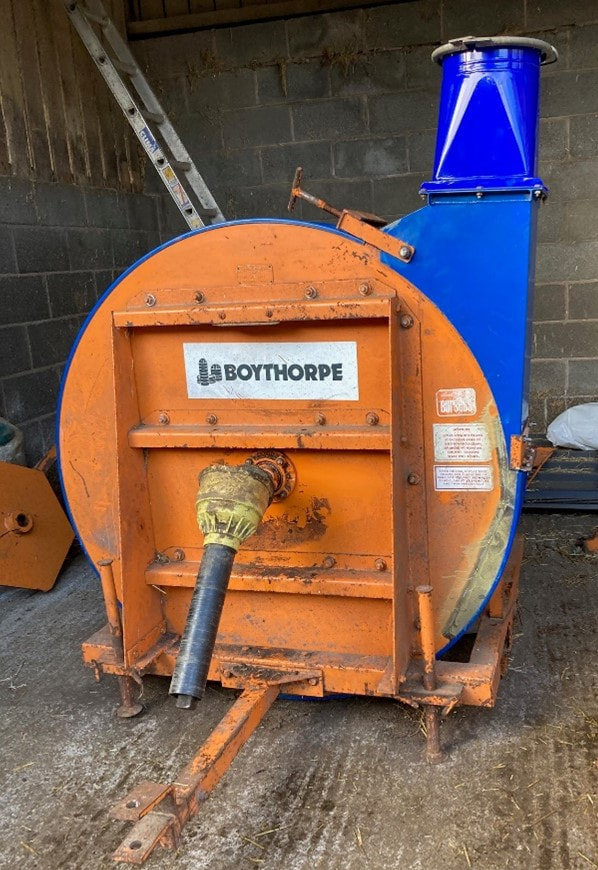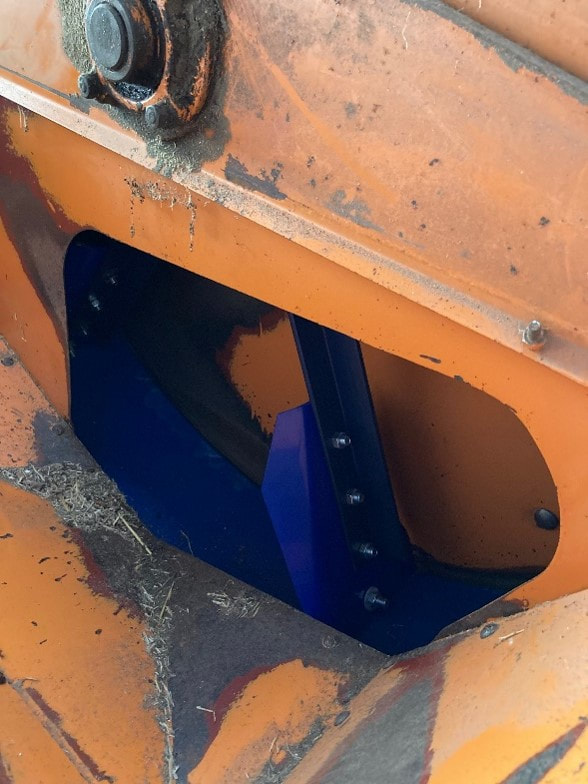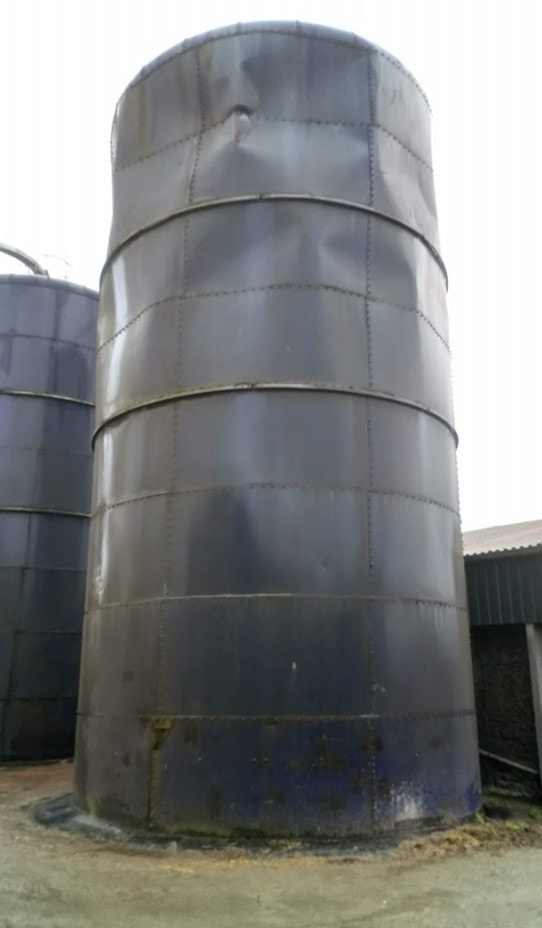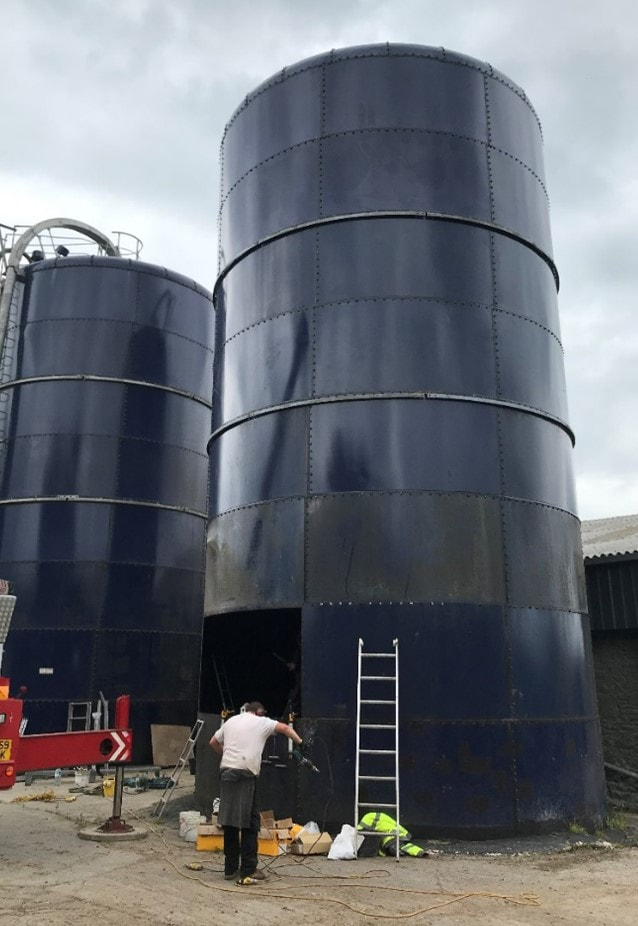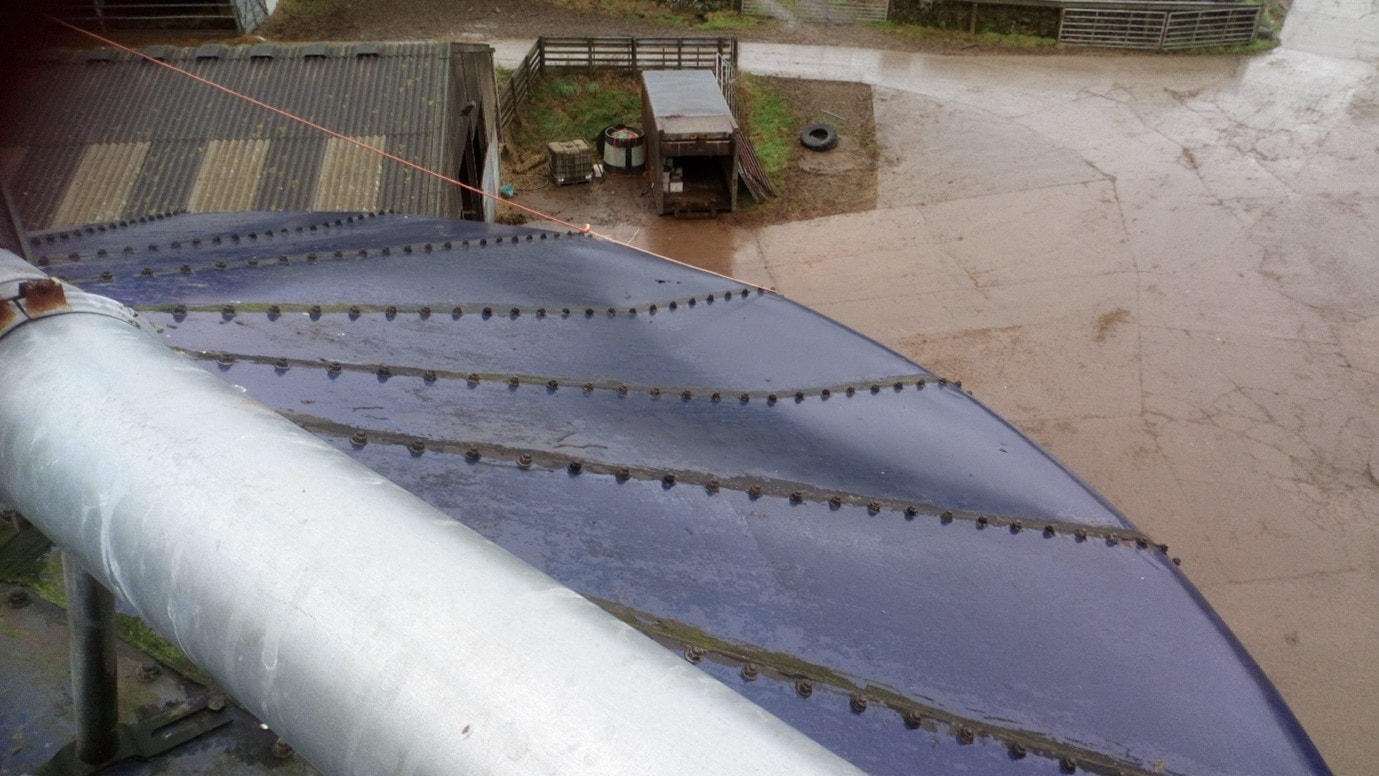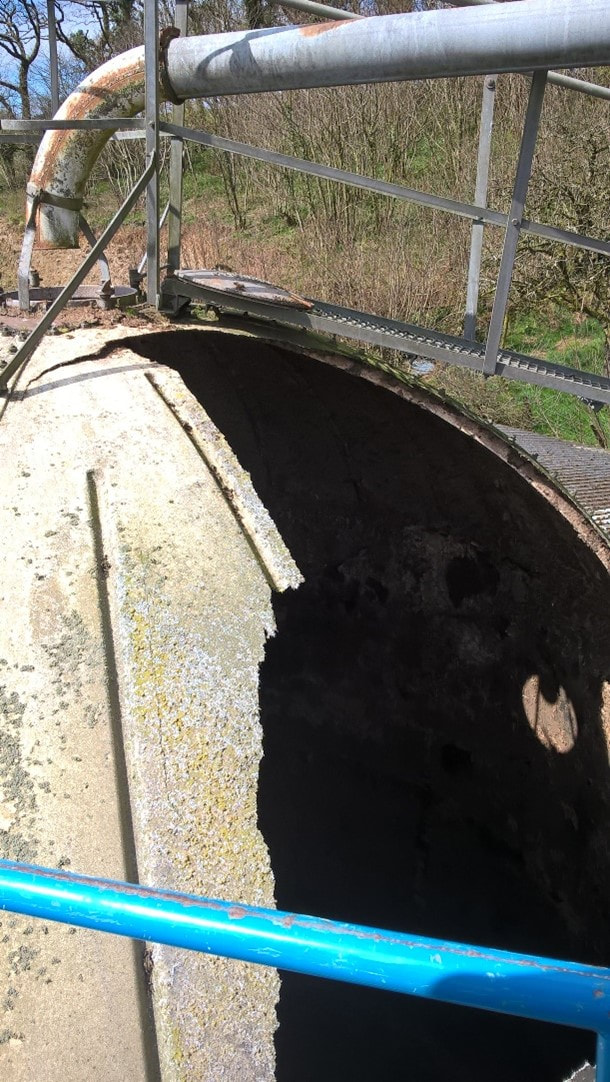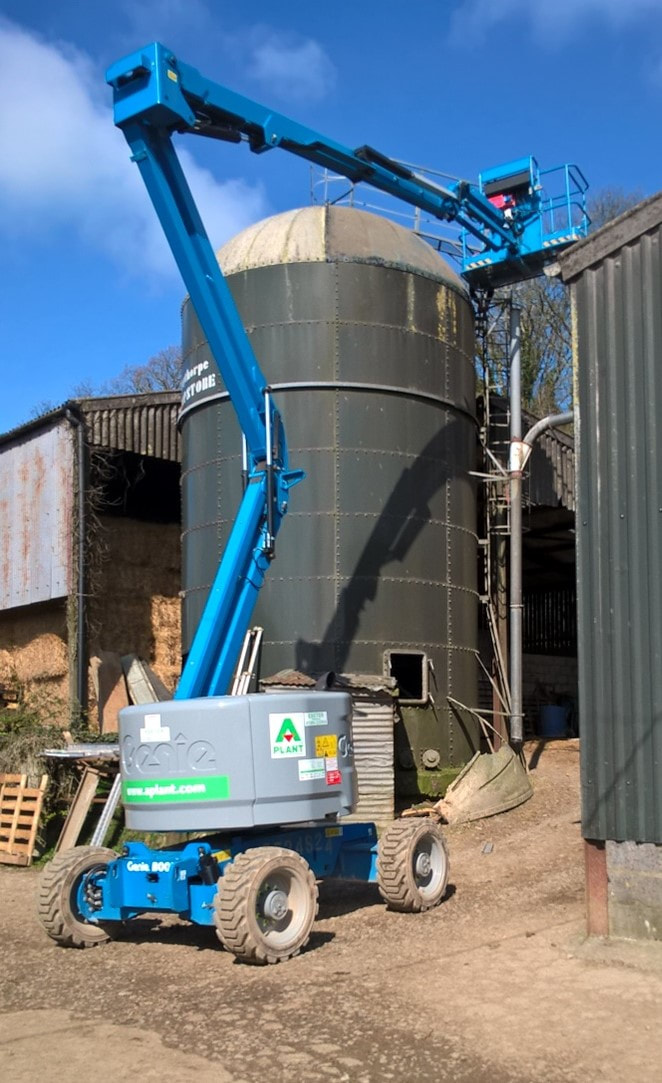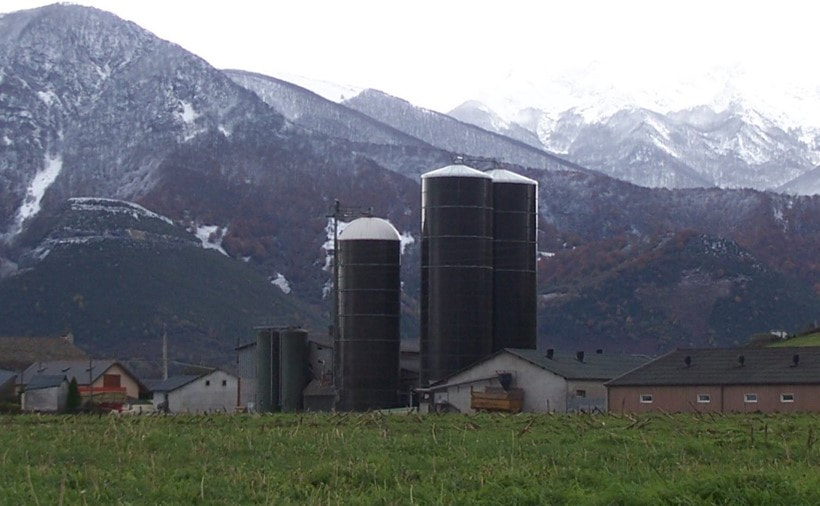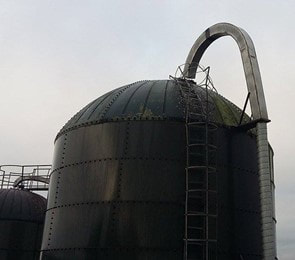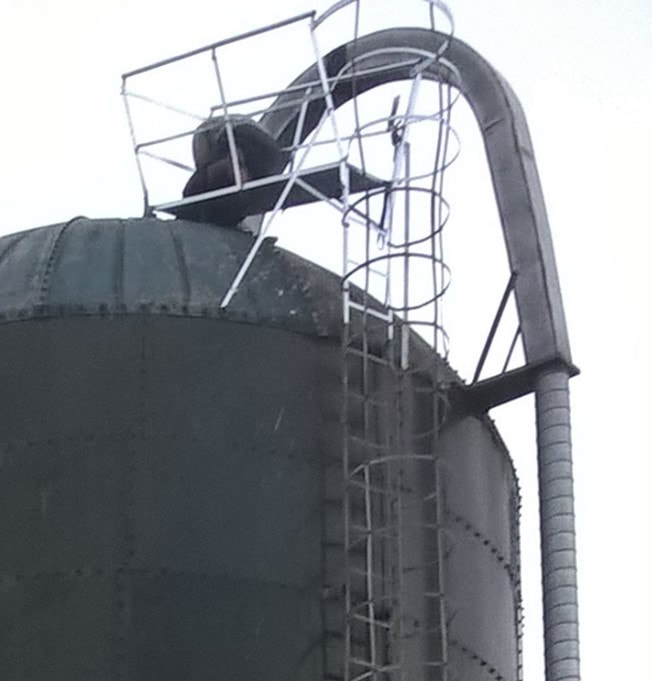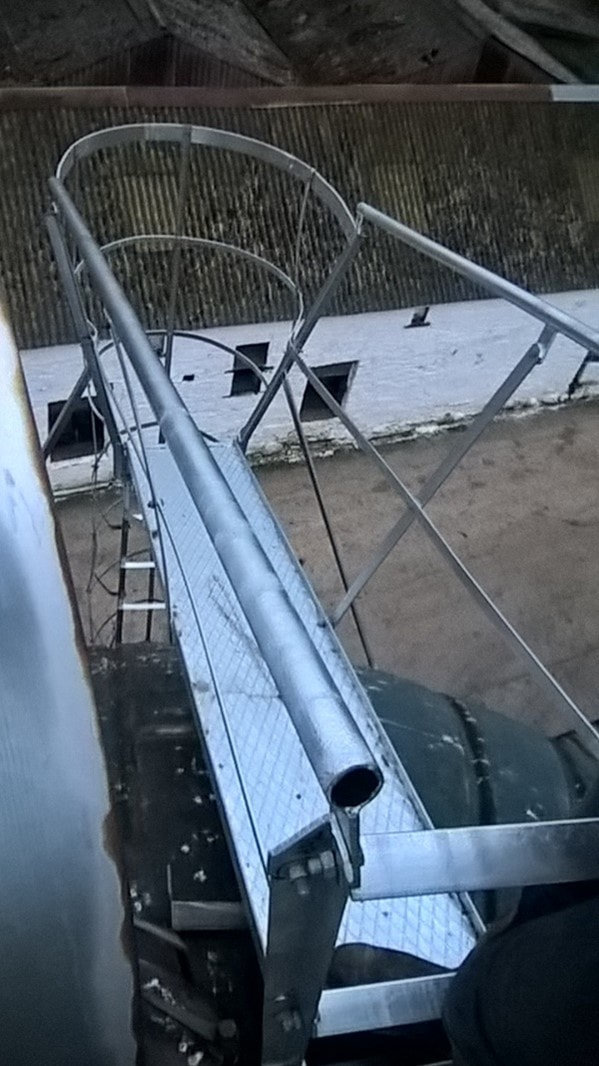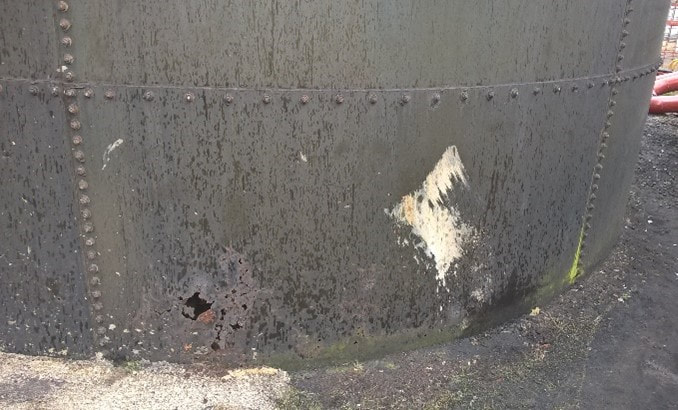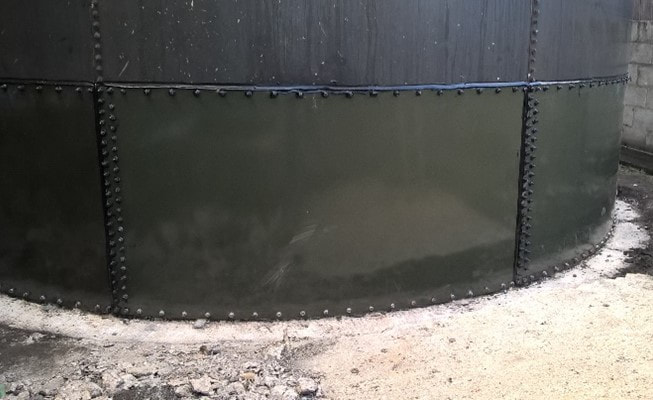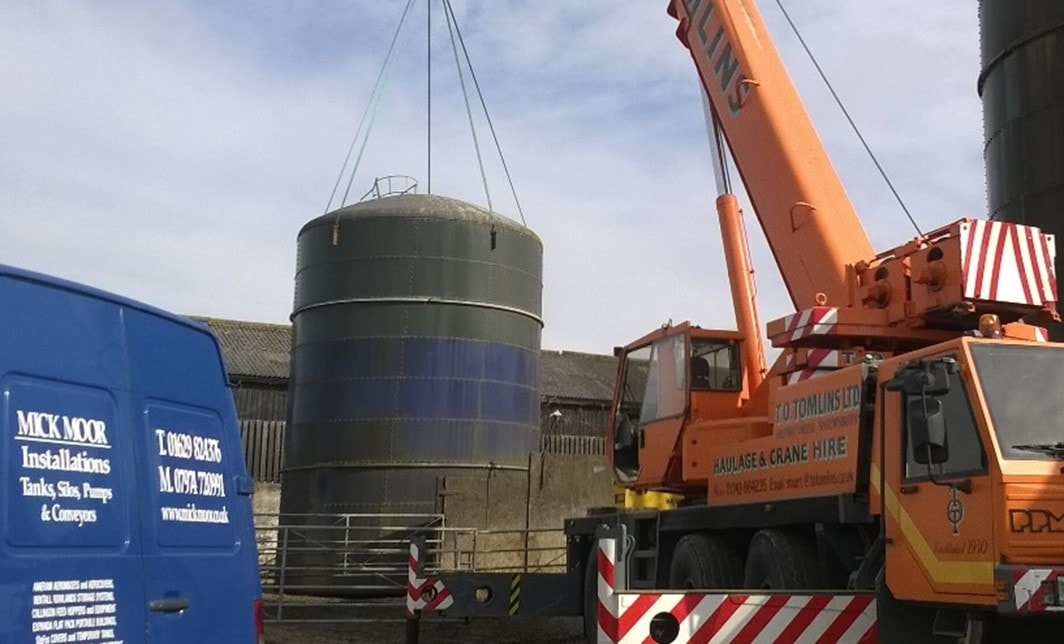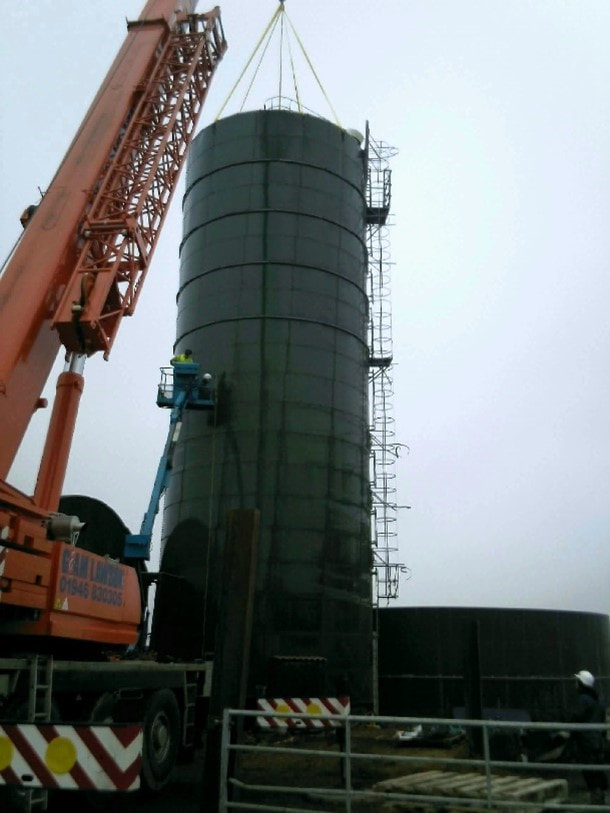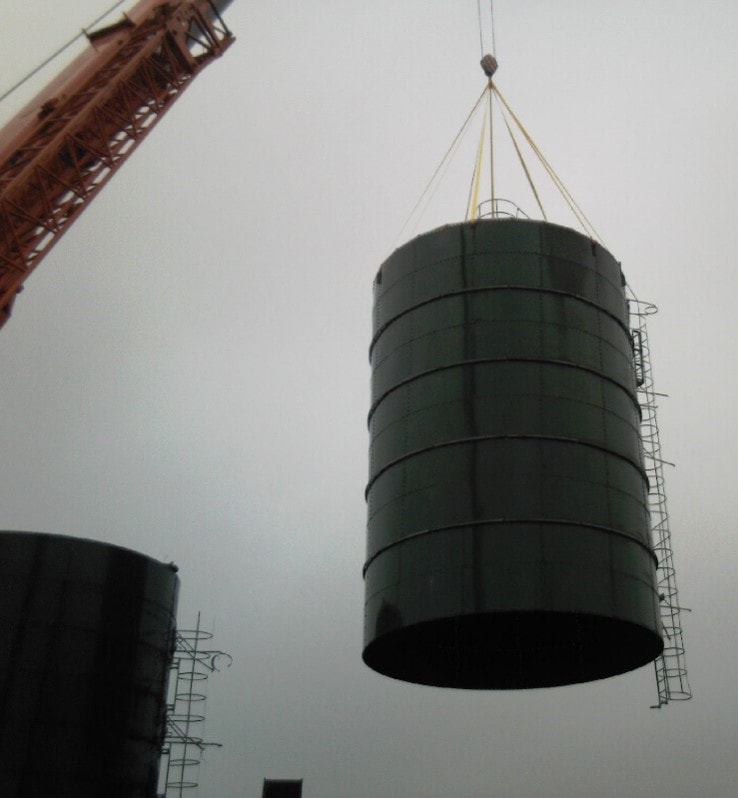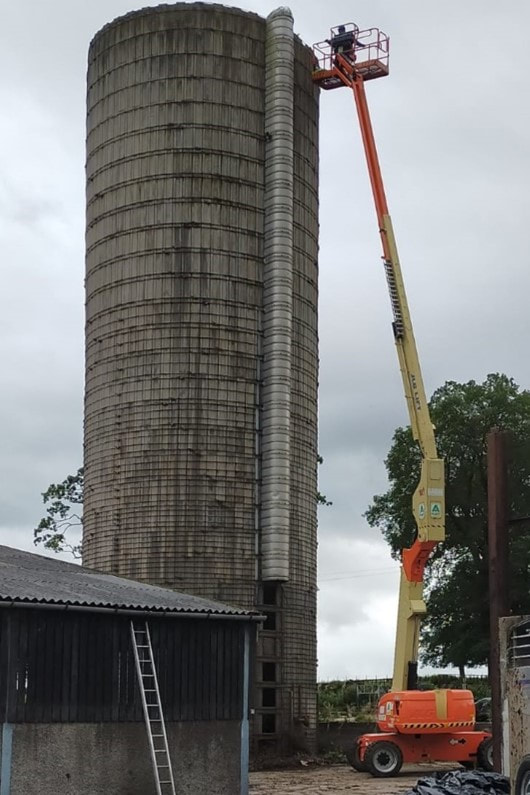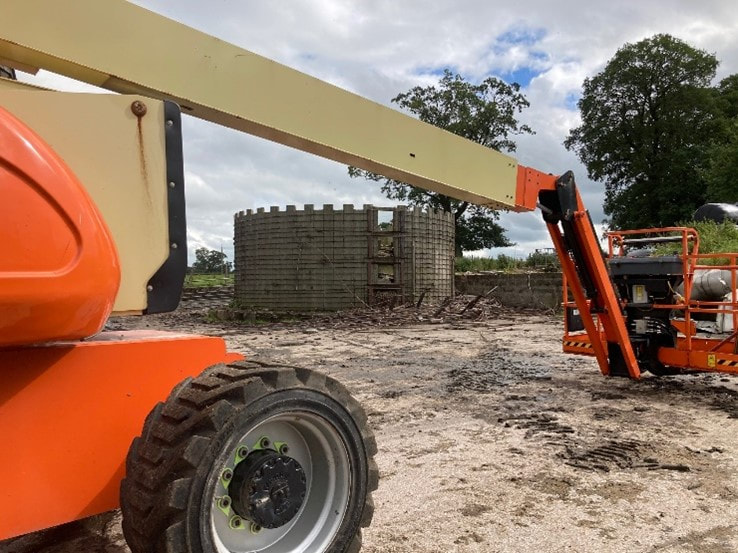Moist Grain Silos
Sealed grain towers were first introduced to farms in the 1960’s. They are an under-rated, sustainable way to store grain for animal feed, with minimal CO2 produced during the process. Originally made by A O Smith, Howard, Harvestore, Simplex and Boythorpe, after the initial expense they were an almost cost-free way of storing barley or wheat, to be fed to the farm’s livestock. The tower silo is a sealed structure; once filled, all hatches are closed, and the living crop uses up the oxygen in the atmosphere by respiration. Moulds, insect pests and even rodents cannot survive, so the crop is preserved.
Because there is no oxygen, it is extremely dangerous to enter a sealed silo without ventilating it well and testing the air inside for oxygen content.
The advantages are however considerable; virtually no wastage, vermin-proof storage, highly palatable (with a slight ‘beery’ smell), less dusty feed, no on-going costs for drying, ‘Propcorn’, or chilling. To a certain extent, the crop can be harvested when it is ready, without waiting for a sustained period of dry weather. The silo can be automatically emptied at a speed which matches a roller mill, and the whole process can be automated. If you wish to re-commission a sealed silo, at the same time reducing your carbon footprint, please give me a call. I can also fit a sweep auger to an existing silo to improve the safety for operators.
Because there is no oxygen, it is extremely dangerous to enter a sealed silo without ventilating it well and testing the air inside for oxygen content.
The advantages are however considerable; virtually no wastage, vermin-proof storage, highly palatable (with a slight ‘beery’ smell), less dusty feed, no on-going costs for drying, ‘Propcorn’, or chilling. To a certain extent, the crop can be harvested when it is ready, without waiting for a sustained period of dry weather. The silo can be automatically emptied at a speed which matches a roller mill, and the whole process can be automated. If you wish to re-commission a sealed silo, at the same time reducing your carbon footprint, please give me a call. I can also fit a sweep auger to an existing silo to improve the safety for operators.
This silo will hold approximately 200t barley. According to a price list, back in 1965 it would have cost £2,500. With a sweep auger adding a further £380. Handrails on the roof ladder, though, were extra! However, no VAT in those days!
Unfortunately, like machinery, moist grain silos do require maintenance, which will prevent a gradual deterioration in the quality of the stored crop. As the silo is filled it stretches, and when emptied relaxes again. This constant movement, combined with expansion and contraction due to temperature variations, and strong winds, gradually wears the mastic sealing the joints between the sheets, letting out carbon dioxide and letting in fresh air and moisture. The rubber seals on the hatches lose their elasticity and deteriorate due to sunlight. Often the valve controlling pressure inside the silo can become blocked. The adjusters for door, filler and emptying hatches often seize up.
Unfortunately, like machinery, moist grain silos do require maintenance, which will prevent a gradual deterioration in the quality of the stored crop. As the silo is filled it stretches, and when emptied relaxes again. This constant movement, combined with expansion and contraction due to temperature variations, and strong winds, gradually wears the mastic sealing the joints between the sheets, letting out carbon dioxide and letting in fresh air and moisture. The rubber seals on the hatches lose their elasticity and deteriorate due to sunlight. Often the valve controlling pressure inside the silo can become blocked. The adjusters for door, filler and emptying hatches often seize up.
A cutaway drawing of a Harvestore grain silo from an old brochure, showing the sweep auger unloading system.
I have copied the operator’s manual for A O Smith sweep arm unloaders. This will be useful for any make of sweep auger. Please email [email protected] for a PDF copy.
Testing
I am probably the only person in the country offering a full test and repair service for all makes of moist grain silos.
Testing involves shutting the silo up, and then blowing air in until the pressure release valve is triggered. This must be checked first, to avoid excessive pressure damaging the silo. All seals on hatches and doors, are them checked by spraying soapy water on them, and looking for bubbles. Finally, the whole structure is tested, including the joint between the silo and base, a common source of trouble. It is surprising how often I find a nut that has never been tightened up! Any leaks are marked with chalk, for appropriate treatment once the silo is no longer pressurised. Occasionally it is cheaper to just apply fresh mastic to every seam, regardless of whether it is leaking or not.
Testing involves shutting the silo up, and then blowing air in until the pressure release valve is triggered. This must be checked first, to avoid excessive pressure damaging the silo. All seals on hatches and doors, are them checked by spraying soapy water on them, and looking for bubbles. Finally, the whole structure is tested, including the joint between the silo and base, a common source of trouble. It is surprising how often I find a nut that has never been tightened up! Any leaks are marked with chalk, for appropriate treatment once the silo is no longer pressurised. Occasionally it is cheaper to just apply fresh mastic to every seam, regardless of whether it is leaking or not.
Leakage under the bottom edge of the silo easily detected with soapy water!
This open seam was leaking so much that it would not have been possible to pressurise the silo to test. The size of the gap can be checked by comparing the number of threads showing beyond the nuts. The seam has been cleaned up ready for fresh Sikaflex mastic to be applied before the bolts are tightened again. Three horizontal seams on the South side of this silo were like this!
Sometimes the original erectors missed tightening a nut, or where the glass has been chipped under the washer, overtightened it.
Good for another few years now!
Pressure release valves can be blocked with corrosion and dust. Cleaned up and re-fitted the storage problem was solved.
Boythorpe valves are particularly prone to blockage! They can only be cleaned by removal followed by dismantling.
The ¼” BSW slot head screws holding them together are often corroded and shear off in the housing! I replace them with stainless hexagon head set screws, BSW thread of course, with plenty of copper grease, to make future dismantling easier without removing the assembly from the silo roof. It is a good idea to replace the gauze to keep flies out.
Seals often need replacing, and the clamps freeing and adjusting. Occasionally the hatch gets buckled, (usually by being dropped) in which case a replacement is the only answer. The slats behind the bottom rectangular hatches keep the pressure of grain off the hatch. Without them, the door will become bowed.
The outlet seal on Harvestore sweep augers wears as grain passes over it. The catch also needs periodic adjustment.
I stock spare most seals including circular hatch seals and rectangular access door seals for any make; Simplex, Boythorpe, Harvestore, Howard, and A O Smith, along with replacement door slats.
Testing and necessary repairs can restore the performance of a sealed silo to ‘as new’ or sometimes even better!
Testing and necessary repairs can restore the performance of a sealed silo to ‘as new’ or sometimes even better!
Repairs
Another reason this type of silo falls into disuse is because the filling pipes, swan-neck and blower have worn and let the grain escape before it even gets into the silo. It is hard to believe how much steel can be worn away by grain!
I can supply and fit replacement pipes to a slightly different design, intended for conveying food material. I replace the swan-neck with pipework which works well and is less costly than copying the original piece. I fabricate an adapter plate so the whole thing can be supported at the eaves, and an adapter ring allows the bottom telescopic part to connect to the blower.
I can supply and fit replacement pipes to a slightly different design, intended for conveying food material. I replace the swan-neck with pipework which works well and is less costly than copying the original piece. I fabricate an adapter plate so the whole thing can be supported at the eaves, and an adapter ring allows the bottom telescopic part to connect to the blower.
A worn-out filler pipe and swan-neck replaced with a new pipe assembly.
A closer view of the top end of the new filler pipe. Telescopic parts allow it to be adjusted for a good fit.
The blower used to fill the silo also wears out. The ends of the paddles wear away, as does the band. Before long, the gap between the two is so large that it no longer blows as well as when new. I can supply all replacement parts for KAM blowers, commonly required are the bands, boot and outlet assembly, paddles, spider, and shaft. The outer diameter of a KAM blower is 54” and the band is 9½” wide.
A new blower will be too expensive to make unless ordered in batches of at least five. However, I can fully re-condition a KAM blower in my workshop.
The blower used to fill the silo also wears out. The ends of the paddles wear away, as does the band. Before long, the gap between the two is so large that it no longer blows as well as when new. I can supply all replacement parts for KAM blowers, commonly required are the bands, boot and outlet assembly, paddles, spider, and shaft. The outer diameter of a KAM blower is 54” and the band is 9½” wide.
A new blower will be too expensive to make unless ordered in batches of at least five. However, I can fully re-condition a KAM blower in my workshop.
Parts replaced on this blower are all blue. After fitting a new spider and paddles, the rotating part had to be balanced.
If the silo is in poor condition, the stored grain goes mouldy, sticking together in lumps, which are difficult to get out of the silo. Sometimes the farmer wants to unload the silo quickly. A sucker-blower is a good machine for this, but it needs a huge constant air supply. If enough air is not allowed in, the silo can implode. Boythorpe silos have a weak roof, which is the first thing to break, Harvestore silos crumple like a crushed can. I can arrange for repairs, usually using mostly second-hand materials.
If the silo is in poor condition, the stored grain goes mouldy, sticking together in lumps, which are difficult to get out of the silo. Sometimes the farmer wants to unload the silo quickly. A sucker-blower is a good machine for this, but it needs a huge constant air supply. If enough air is not allowed in, the silo can implode. Boythorpe silos have a weak roof, which is the first thing to break, Harvestore silos crumple like a crushed can. I can arrange for repairs, usually using mostly second-hand materials.
Repairs to an imploded Harvestore silo.
Even the roof was damaged!
Replacing a roof panel on a Boythorpe silo.
Sometimes, silos can be damaged by other causes. If the material bridges and then suddenly falls, it can damage the silo. A large maize silo in the foothills of the Pyrenees was empty in the summer of 2005, the temperature was 41°C. A sudden hailstorm rapidly reduced the temperature to 7°C. The air inside contracted, and the pressure controls could not admit more air quickly enough, resulting in an implosion.
Sometimes, silos can be damaged by other causes. If the material bridges and then suddenly falls, it can damage the silo. A large maize silo in the foothills of the Pyrenees was empty in the summer of 2005, the temperature was 41°C. A sudden hailstorm rapidly reduced the temperature to 7°C. The air inside contracted, and the pressure controls could not admit more air quickly enough, resulting in an implosion.
The large silo nearest the camera imploded. We were sent to fix the roof after the body of the silo had been re-built.
Some older silos have unsafe access to the filling hatch. A catwalk from a dismantled silo will improve matters no end! We also made a replacement swan-neck.
I had the replacement catwalk re-galvanised!
Some of these silos were used to store coal at places like market gardens and hospitals.
The filling process can damage the coating on the inside of the silo sheets, resulting in corrosion, eventually requiring replacement.
Some of these silos were used to store coal at places like market gardens and hospitals.
The filling process can damage the coating on the inside of the silo sheets, resulting in corrosion, eventually requiring replacement.
In this case the only replacement sheets we could find to fit this Boythorpe silo were thicker, with a stronger bolt pattern. This particular silo was being converted for biofuel such as wood chip.
Dismantling and Re-building
Originally, this type of silo was built by assembling the top ring and roof, with catwalk and all other parts fitted while at ground level, then jacking the whole thing up, fixing one ring of sheets after another underneath. I have developed a similar way of doing this using a crane instead of jacks. This is notably quicker when dismantling a silo. With a big enough crane this works for forage towers too.
Dismantling a grain silo.
Because we could not get the crane close to the job, a 120t machine was used to lift the top off a forage tower. The silo still contained silage below this level, so a small digger was craned on top of the crop to dig it out. Removing sheets as work progressed.
Although not many remain, I have a proven, safe method of demolishing concrete stave tower silos, with minimal chance of damage to anything nearby. It is expensive to carry continuous insurance for this type of work, so each is insured separately.
Although not many remain, I have a proven, safe method of demolishing concrete stave tower silos, with minimal chance of damage to anything nearby. It is expensive to carry continuous insurance for this type of work, so each is insured separately.
A silo assembled using a crane, almost ready to be placed on top of the base ring on the left. One sheet is left out for access and to help communication amongst the team.

